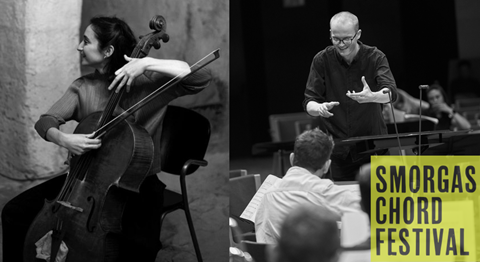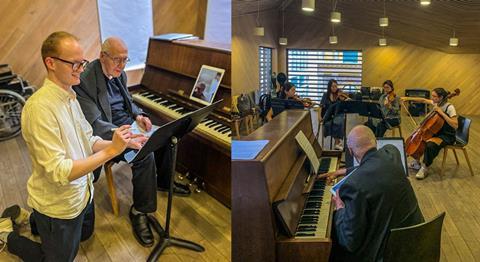In advance of the Smorgaschord festival, directors Eliza Millett and Sebastian Black share their experiences with contemporary string repertoire

Discover more Featured Stories like this in The Strad Playing Hub
A cellist’s perspective…
Eliza Millett
Nuance is everything – this much we know. And nothing is more nuanced than working with a living composer, who charts and maps within an inch of their being every gesture they pen. It is another thing entirely putting these gestures into practice, however.
In my time working with György Kurtág, particularly on his Zwiegespräch for string quartet and electronics, it was clear that this was a composer who delineates meaning in gesture – a master of the miniature, no less. Short, compact ideas are to be conveyed perfectly – a sul pont or con sordino metallico must be expertly mastered to fit the whole character of the idea. The care and commitment that so much contemporary music is given by its composers deserves the same from the performer – and what a gift it is to have a composer alive to ask puzzling questions relating to the score, rather than trawling through editions and comparing Bärenreiter wedges to Henle staccatos (also a favourite pastime – those early editions are gold mines!)
Working on the music by Gérard Pesson at Yellow Barn Festival in Vermont was another great experience of real ‘hardcore’ contemporary repertoire, so to speak. Working for almost five weeks on Pesson’s Le Gel, par jeu (for violin, cello, flute, clarinet and marimba) required a whole new set of extended techniques. The overall effect and in turn the final performance of the piece was an utter highlight of the festival, as we excavated the shape and feeling of the piece, mostly focusing on the groove and how distinctive sounds correlate.
Looking ahead to this year’s festival and in particular working with Mark Simpson and playing his piece Ariel for basset clarinet, violin, cello and piano, I am once again presented with a new set of exciting challenges. Fundamental to this work is a certain rigour of structure, which makes for an organised and cohesive rehearsal and practice process. In my time learning this piece (with the aid of a recording), I have discovered all over again the importance of specificity of markings and rhythmic groove. There is such beauty and elegance that permeates this work, and it will be a tour de force of a performance, paired with Messiaen’s Quartet for the End of Time. Stamina and strength for this evening concert are mandatory!

A composer’s perspective…
Sebastian Black
Composing for stringed instruments is tremendous fun. It is wonderful to push players to do things just beyond their limits, taking traditional techniques a little bit further than they’re used to, pushing them to find new ways of expressing themselves with their instrument and taking them a bit outside of their comfort zone.
In the past 50 or so years, composers have explored endless possibilities of extended techniques, searching for totally new sounds within the instrument. Other composers have delved deep into the world of microtones, exploring the infinitesimal subtleties of pitch that strings naturally offer. These new discoveries present the composer of today with a million new fascinating options for making their music sound intriguing and beautiful. A composer like Pesson, for example, will often use some of these techniques (commonly associated with very, very serious German music!) and turn them into something witty and ever-so-slightly satirical – very different from the world with which they were originally associated.
Kurtág, however, is a different matter altogether. The sounds in his string music are as extreme as anything. But, and our sessions with him confirmed this to me, his approach to strings is rooted in tradition, particularly the wonderful Hungarian string tradition, and the musicians with whom Kurtág is associated: violinists such as Sándor Végh and András Keller. When Kurtág teaches chamber music you can just hear how he has been informed by his interactions over the decades with these extraordinary musicians.
Most striking, I found, was Kurtág’s approach to the idea of contact between the bow and string. In quiet music, he so often says, you absolutely must retain that contact. That way, the music will speak and will project out to the audience. This I found fascinating. So often musicians go completely inward when playing quietly, and the result is often a rather bland (if pearly) sound that lacks any sense of weight at all. (I can say that I am extremely prone to this when playing the piano!)
Recently, I was working on a new piece of mine with the wonderful, and very fun, musicians of the WDR Symphony Orchestra Academy in Cologne, and I often found myself using Kurtág’s phrases (‘maintain contact, maintain contact!’) in my work with them. The results I found were transformative – it’s like he’s developed this amazing language for rehearsals that string players can relate to incredibly well and easily. Also, with bowing, it’s wonderful to push string players to use their bow fully, and, for example, to try to find immense expression in the upper portion of their bow too. (The broadcast of the piece was on WDR 3 on 4 June should anyone want to listen!)
In some ways, Kurtág’s string writing to me sounds very modern: a piece like Cassandra Miller’s astonishing viola concerto I cannot love without trembling seems to come straight out of the same world, while being completely original, captivating and desperately beautiful. The techniques that are called for Lawrence Power do not require a great reinvention of the wheel, so to speak, but a greater depth of possibility in the relationship between the bow and string. This creates music of immense expressive power: the fragility of the viola’s delicate architecture is brought to the fore, and consequently music of such depth and intimacy pours forth. The viola weeps, it sings, and it consoles.
The 2024 Smorgaschord festival will take place on 22 June in Oxford. Find more information here
Read: ‘Composer fun is the best fun!’ - Post-festival Q&A with the Smorgaschord festival directors
Read: ‘Unusualness in all its splendour’: Q&A with the Smorgaschord festival directors
Discover more Featured Stories like this in The Strad Playing Hub
The number one source for playing and teaching books, guides, CDs, calendars and back issues of the magazine.
In The Best of Technique you’ll discover the top playing tips of the world’s leading string players and teachers. It’s packed full of exercises for students, plus examples from the standard repertoire to show you how to integrate the technique into your playing.
The Strad’s Masterclass series brings together the finest string players with some of the greatest string works ever written. Always one of our most popular sections, Masterclass has been an invaluable aid to aspiring soloists, chamber musicians and string teachers since the 1990s.
American collector David L. Fulton amassed one of the 20th century’s finest collections of stringed instruments. This year’s calendar pays tribute to some of these priceless treasures, including Yehudi Menuhin’s celebrated ‘Lord Wilton’ Guarneri, the Carlo Bergonzi once played by Fritz Kreisler, and four instruments by Antonio Stradivari.





































No comments yet